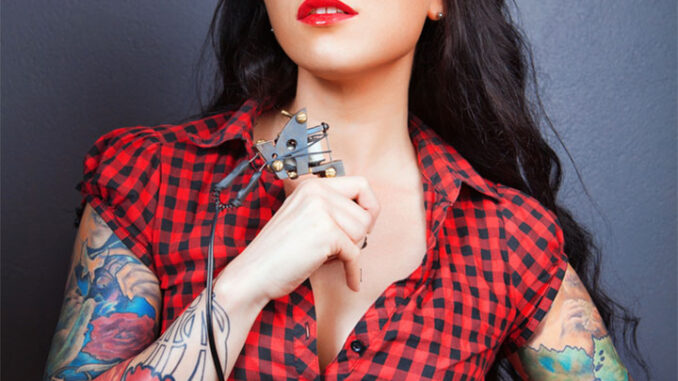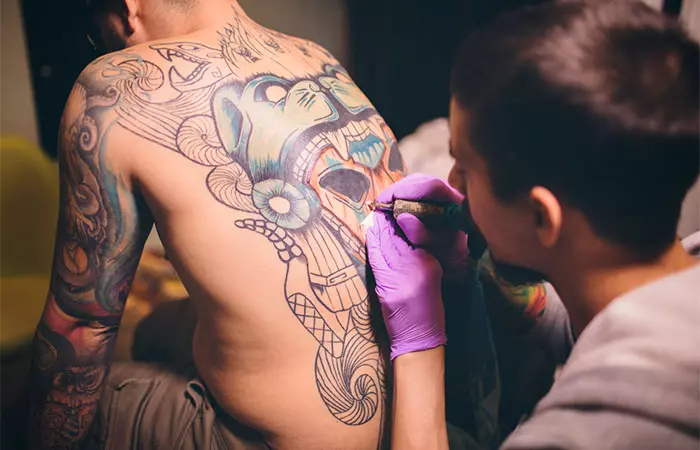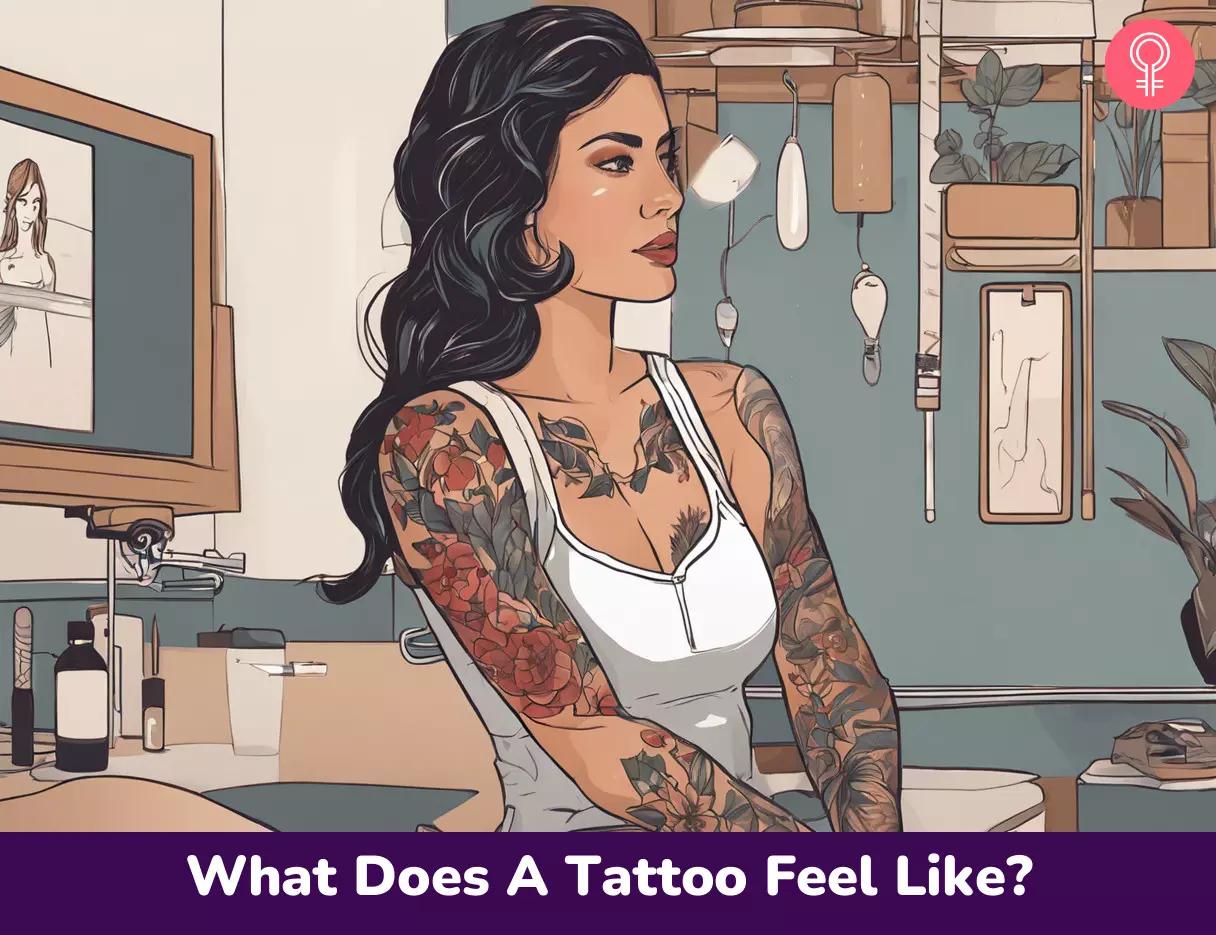
If you want to go for a tattoo but are apprehensive about the process and the feel of it, then you are in the right place to address your doubts. What does a tattoo feel like? This is a natural question for first-timers, and one thing we know for sure is that it is a sensory experience that may seem terrifying but can be quite satisfying too if done right. Tattoos are a great way to ink your stories and wear your personality on your body, but the buzzing of the tattoo gun can discourage one from getting one. Do not let your fears get the better of you– we are here to help you get that beautiful tattoo design you have been eyeing. Keep scrolling to learn more!
What Does Getting A Tattoo Feel Like?
Getting a tattoo may feel like a continuous, stinging sensation akin to a mosquito bite but sharper. The tattoo needle penetrates layers of skin to administer the ink which causes discomfort. While the pain is sharp initially, your body adjusts, and the sensation becomes more tolerable over time. The intensity of the pain may vary depending on the location; for example, the chest and wrists are generally known to be more painful tattoo spots due to heightened sensitivity. The process involves a mix of irritation and a burning feeling, but the pain is bearable for most. Afterward, the tattooed area may feel sore, akin to a mild sunburn, which can persist for a day or two. Overall, the sensation is manageable, and the end result often outweighs the temporary discomfort.
While most people describe the pain of getting a tattoo as similar to a mosquito bite but sharper, it may vary from person to person. The next section elaborates on the different levels of pain one may experience during a tattoo session.
What Does Tattoo Pain Feel Like?
 Image: IStock
Image: IStock
Tattooing brings a constant stinging sensation. It may make you flinch the first few minutes as the needle starts to penetrate your skin but you get accustomed to the feeling soon. The feeling of getting a tattoo is often said to be similar to getting stung by a bee. Initially, the pain is intense, gradually numbing as your body adapts. Sensations vary by location, with more sensitive areas intensifying the discomfort. The process induces a mix of irritation and a burning sensation, but it is generally manageable for most.
Post-tattoo, the area may remain sore, resembling a mild sunburn, which can last a day or two. It may last a little longer if you are getting a larger tattoo design that requires multiple tattoo sessions. Some people are extremely sensitive to the feeling of the needle, the sound of the tattoo machine, or the sight of blood. You may experience some lightheadedness, but it usually passes soon enough. If you feel overwhelmed, it is best to inform your tattoo artist and take a break.
A blogger, previously uninterested in getting a tattoo, decided to share their experience of getting one. They write, “Like I said, I was never against the idea of getting a tattoo done, but I just lacked the motivation or should we say, incentive, to endure the skin piercing needles for 2 hours (i).” While talking about the pain, they continue, “But truth be told, when the needle hits you, you’ll know it. When they do a round 2 on your tattoo, you’ll feel as if your skin is on fire, but keep a straight face and listen to your music.”
The pain is bearable for most but several reasons on any given day may increase your sensitivity and make the tattooing process a more painful ordeal than it needs to be. Let us find out some of the common factors behind the pain below.
Factors That Influence Tattoo Pain
There are several factors that may influence how much pain you experience while getting a tattoo. Some of the most common ones are mentioned below.
Placement: Certain body parts are more sensitive than others. The ribs, collarbone, and spine often yield a higher pain response, while areas like the forearm and calf are generally more bearable. Skin Thickness: The thickness of your skin plays a role. Thicker skin, found on the back, may result in a milder sensation compared to thinner skin areas like the wrist or ankle. Individual Pain Threshold: Personal pain tolerance levels vary from individual to individual. If you have a high pain threshold, the tattooing process may be more manageable for you. Concentration Of Nerve Endings: Areas with a higher concentration of nerve endings, such as fingers or toes, can amplify the pain sensation during tattooing. Tattoo Size And Complexity: Larger or intricate tattoos often take longer to complete, potentially causing more discomfort. The continuous needle action may contribute to a more intense sensation. Individual’s Mental State: Your psychological state influences pain perception. Anxiety and stress can heighten pain sensitivity, making the experience more challenging. A calm mindset can contribute to a smoother process. Experience Of The Tattoo Artist: The expertise of your tattoo artist can make a lot of difference. A skilled and efficient artist can easily find the right depth to deliver the ink, minimize the duration of the process, and reduce overall discomfort. Hydration Levels: Well-hydrated skin is more pliable and tends to handle the tattooing process better. Dry skin may be more prone to irritation and cause more pain.
Celebrity tattoo artist Mark Mahoney, renowned for inking icons such as Johnny Depp and Angelina Jolie, admires David Beckham for his remarkable pain tolerance. He marvels at Beckham’s ability to endure tattoo sessions in the most sensitive areas without showing any signs of discomfort.
Despite the initial discomfort, you may find the pain tolerable, seeing that it is a worthwhile trade-off for a lasting body art. Does the amount of pain you experience depend on the body part you are getting tattooed? Let us find out in the next section.
What Getting A Tattoo On Various Parts Of The Body Feels Like
 Image: IStock
Image: IStock
Getting a tattoo is a unique experience, and the sensation of getting one varies across different body parts. The pain level also depends on the tattoo placement. Let us look at some of the ideal body parts to get a tattoo below.
Forearm: Causes a consistent, manageable stinging sensation. The discomfort is the same as scratching a healing sunburn, making it tolerable for most. Ribs: You may experience a sharp, intense pain as the needle passes over the rib cage. If you have a higher pain threshold, then you may opt for a rib tattoo. Inner Wrist: It is a sensitive area and may lead to sharp, stinging pain. Those with a high pain tolerance will find it to be a unique tattooing experience but it may be difficult for some. Calf: It causes moderate and dull pain with a continuous vibration-like feeling. Tolerable for the majority, you may feel the occasional sharper jabs of the needle during the tattoo process. Shoulder/Upper Arm: Expect mild discomfort, feeling like a series of pricks. It may cause some numbness over the area, making the pain more tolerable. Ankle: The tattooing sensation here is a mix of stinging and vibration. The level of pain depends on the side of the ankle you are targeting. Only seasoned tattoo enthusiasts are recommended to attempt it. Spine: Brace yourself for an intense, vibrating pain along the spine. Uncomfortable, the endurance required varies widely among individuals. Thigh: You may experience moderate pain due to repeated pinpricks that characterize the thigh tattoo experience. The inner thigh area is more sensitive than the outer thigh so getting a tattoo on there will hurt less. Collarbone: Getting a collarbone tattoo results in sharp and intense pain due to the presence of bones. Finger/Toe: Prepare for a pinching and sharp pain with toe or finger tattoos. The discomfort is localized, but the pain can be surprisingly high, especially in the case of foot tattoos.
The tattoo process usually does not hurt much if you avoid the more sensitive areas of your body, such as fingers and toes, collarbone, wrist, spine, and ribs. If your pain tolerance is exceptionally high, you can opt to get inked on some of the more painful tattoo spots . But what does your skin feel like after you get it? Find out below.
How Does It Feel After The Tattoo Procedure?
After the tattoo procedure, you will likely experience some soreness and redness in the tattooed area. It feels similar to a sunburn with a lingering tenderness. Swelling may occur initially, but it typically subsides within a day or two. The skin around the tattoo might be sensitive to the touch.
Proper tattoo aftercare is crucial to ensure a smooth recovery of your sensitive skin. Apply the recommended antibacterial ointments and keep the area clean by using a mild soap and lukewarm water. As the days pass, the discomfort diminishes, and the healing tattoo evolves into a permanent piece of art.

Eat a balanced meal before your tattoo appointment and pack sweet and savory snacks along with water. This helps maintain blood sugar levels and prevents fatigue during the tattoo session.
While the tenderness and swelling go away in a couple of days, you need to take special care of your tattoo as it heals. Let us find out more about the tattoo healing period in the next section.
What Do Tattoos Feel Like While Healing?
 Image: Shutterstock
Image: Shutterstock
Like any wound, a tattoo initially becomes red and swollen with the occasional discharge. After 1-2 days, the swelling reduces and you start to see the scabbing form over the healing tattoo. This is a part of your skin’s healing process. During this time, it is essential that you keep the area clean and moisturized, while also using antibiotic ointments and bandages to protect the area from getting injured which may increase the risk of infection. The area may also feel itchy as a result of healing. No matter how much it itches or pulls, it is best to leave it alone so that it does not affect the overall look of your tattoo. It is also recommended that you opt for loose clothes that will not pull on your healing scabs.
The superficial healing of the skin takes 2-3 weeks after which it is recommended that you use a sunscreen with SPF 30 or above to protect the area from direct sun exposure. Following the proper tattoo aftercare instructions recommended by a skilled tattoo artist is the best way to ensure that your tattoo heals properly.
Getting a tattoo is a sensory journey with ink pigments etched into your skin that tell a unique story. From the initial sting, varying in intensity across body parts, to the post-procedure soreness resembling a healing sunburn, every sensation contributes to the tattooing process. As your tattoo heals, the tenderness, subtle throbbing, and temporary discomfort become part of a fleeting phase leading to the permanent display of your chosen art. It is essential to get a tattoo from a good tattoo parlor and follow the proper aftercare routine recommended by your experienced artist. This may help you avoid mishaps with the tattoo design, prevent allergic reactions to tattoo ink, and reduce the risk of infection. Seek medical attention if you notice any unnatural discharge and consult with a licensed tattoo artist on how to proceed for optimal tattoo healing.
Frequently Asked Questions
Do you cry during a tattoo?
Crying is not uncommon while getting a tattoo. Most people handle the pain well, but the level of pain tolerance in individuals varies.
How long does tattoo pain last?
Tattoo pain typically lasts for a few hours to a few days. The intensity diminishes rapidly after the procedure, and any residual soreness or discomfort usually subsides within 24 to 72 hours.
What does a tattoo feel like on your arm?
Getting a tattoo on your arm often feels like a consistent, manageable stinging sensation. The pain is generally tolerable, resembling the feeling of a cat scratch. Over time, the discomfort may decrease as your body adapts, making the process more manageable.
Key Takeaways
Getting a tattoo feels like a constant stinging sensation. It feels more painful during the initial stages, but it becomes more manageable as your body adapts to the sensation. Expect some soreness afterward, resembling a mild sunburn, which typically subsides within a day or two. Areas such as the fingers, toes, neck, rib cage, and collarbones are painful spots to get a tattoo due to the presence of bones.
Image: Stable Diffusion/StyleCraze Design Team
It is natural to be wary of the pain before getting your first tattoo. The following video discusses the sensations associated with tattooing, addresses questions about its intensity, and provides insights on coping mechanisms to alleviate the fear of pain. Check it out to learn some tips on how to go about preparing for your first tattoo!
Personal Experience: Source
Was this article helpful? ReviewerAuthorEditorFact Checker
![]() Brik Rangel is a highly skilled tattoo artist who has 12 years of experience in the field. She specializes in transformative tattoo makeovers and cover-ups. After honing her craft in São Paulo, Brazil, she now works as a tattoo artist and manager at Manhattan Tattoos in New York, and as a tattoo artist at Divine Tattoos in New Jersey.
Brik Rangel is a highly skilled tattoo artist who has 12 years of experience in the field. She specializes in transformative tattoo makeovers and cover-ups. After honing her craft in São Paulo, Brazil, she now works as a tattoo artist and manager at Manhattan Tattoos in New York, and as a tattoo artist at Divine Tattoos in New Jersey.
Read full bio of Brik Rangel
![]() Shreya is a beauty and lifestyle writer with two years of experience. After graduating from Christ University, Bengaluru, she started as a writer for a non-profit organization, Bhumi, as an intern. She then wrote for a progressive content website.
Shreya is a beauty and lifestyle writer with two years of experience. After graduating from Christ University, Bengaluru, she started as a writer for a non-profit organization, Bhumi, as an intern. She then wrote for a progressive content website.
Read full bio of Shreya Mukherjee
![]() Subhrojyoti is an associate editor at StyleCraze with four years of experience. He has a master’s degree in English from Presidency University, Kolkata, and has also done a post-graduate certificate course in Editing and Publishing from Jadavpur University, Kolkata.
Subhrojyoti is an associate editor at StyleCraze with four years of experience. He has a master’s degree in English from Presidency University, Kolkata, and has also done a post-graduate certificate course in Editing and Publishing from Jadavpur University, Kolkata.
Read full bio of Subhrojyoti Mukherjee
![]() Gazala Ansari is a beauty and lifestyle writer with two years of experience. She writes on relationships, makeup, and lifestyle and has bachelor’s and master’s degrees in English literature from the Central University of Jharkhand.
Gazala Ansari is a beauty and lifestyle writer with two years of experience. She writes on relationships, makeup, and lifestyle and has bachelor’s and master’s degrees in English literature from the Central University of Jharkhand.
Read full bio of Gazala Firdos Ansari
Leave a Reply